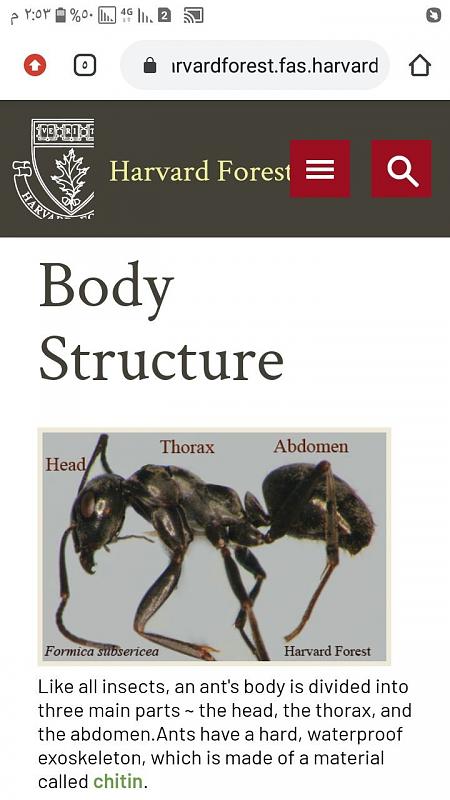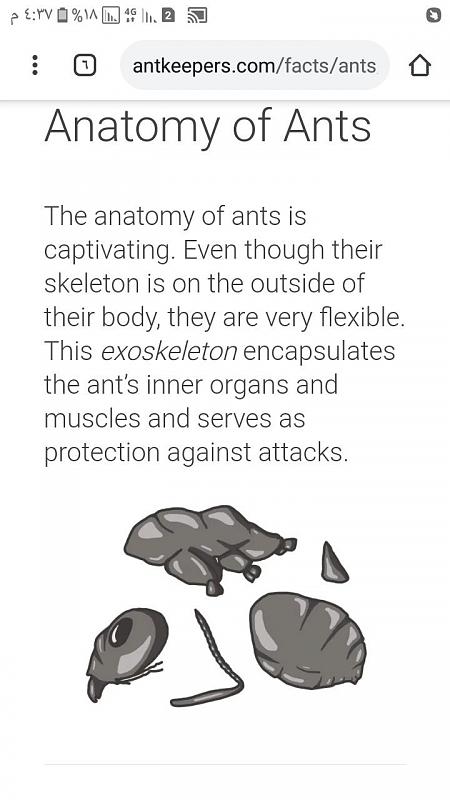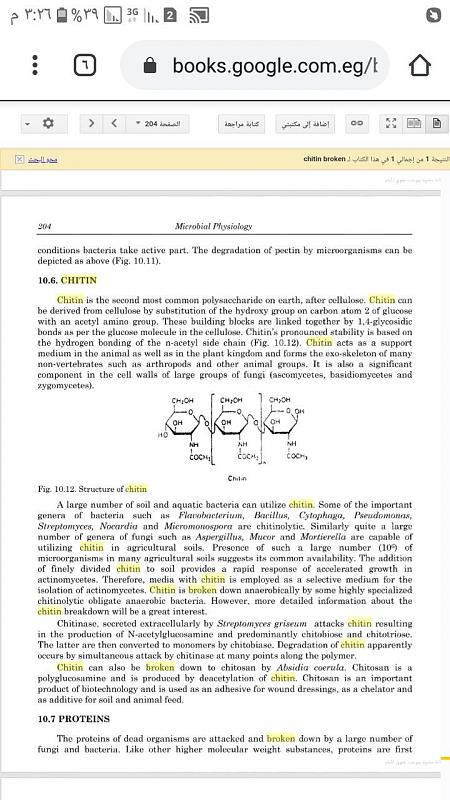Body Structure
Like all insects, an ant's body is divided into three main parts ~ the head, the thorax, and the abdomen.Ants have a hard, waterproof exoskeleton, which is made of a material called chitin.
They are exceptionally strong for their size- They can lift 10 times their own weight!

الرابط
Body Structure
Chitin: a tough, protective, semitransparent substance that forms the exoskeletons of arthropods
Exoskeleton: hard outer shell of arthropods made of chitin
الرابط
Glossary
الهيكل الخارجي
Arthropod exoskeleton
Arthropods are covered with a tough, resilient integument or exoskeleton of chitin. Generally the exoskeleton will have thickened areas in which the chitin is reinforced or stiffened by materials such as minerals or hardened proteins. This happens in parts of the body where there is a need for rigidity or elasticity. Typically the mineral crystals, mainly calcium carbonate, are deposited among the chitin and protein molecules in a process called biomineralization. The crystals and fibres interpenetrate and reinforce each other, the minerals supplying the hardness and resistance to compression, while the chitin supplies the tensile strength. Biomineralization occurs mainly in crustaceans; in insects and Arachnids the main reinforcing materials are various proteins hardened by linking the fibres in processes called sclerotisation and the hardened proteins are called sclerotin. Four sclerites form a ring around each segment: a dorsal tergite, lateral sternites and a ventral pleurite.
In either case, in contrast to the carapace of a tortoise or the cranium of a vertebrate, the exoskeleton has little ability to grow or change its form once it has matured. Except in special cases, whenever the animal needs to grow, it moults, shedding the old skin after growing a new skin from beneath.
الخصائص الميكانيكية لهذه الطبقة
Mechanical properties
The two layers of the cuticle have different properties. The outer layer is where most of the thickening, biomineralization and sclerotisation takes place, and its material tends to be strong under compressive stresses, though weaker under tension.[2] When a rigid region fails under stress, it does so by cracking.[2] The inner layer is not as highly sclerotised, and is correspondingly softer but tougher; it resists tensile stresses but is liable to
failure under compression.[2]
This combination is especially effective in resisting predation, as predators tend to exert compression on the outer layer, and tension on the inner.[2]
Its degree of sclerotisation or mineralisation determines how the cuticle responds to deformation. Below a certain degree of deformation changes of shape or dimension of the cuticle are elastic and the original shape returns after the stress is removed. Beyond that level of deformation, non-reversible, plastic deformation occurs until finally the cuticle
cracks or splits. Generally, the less sclerotised the cuticle, the greater the deformation required to damage the cuticle irreversibly. On the other hand, the more heavily the cuticle is armoured, the greater the stress required to deform it harmfully.[2]
As a rule, the arthropod exoskeleton is divided into different functional units, each comprising a series of grouped segments. Such a group is called a tagma, and the tagmata are adapted to different functions in a given arthropod body. For example, tagmata of insects include the head, which is a fused capsule, the thorax as nearly a fixed capsule, and the abdomen usually divided into a series of articulating segments. Each segment has sclerites according to its requirements for external rigidity; for example, in the larva of some flies, there are none at all and the exoskeleton is effectively all membranous; the abdomen of an adult fly is covered with light sclerites connected by joints of membranous cuticle. In some beetles most of the joints are so tightly connected, that the body is practically in an armoured, rigid box. However, in most Arthropoda the bodily tagmata are so connected and jointed with flexible cuticle and muscles that they have at least some freedom of movement, and many such animals, such as the Chilopoda or the larvae of mosquitoes are very mobile indeed. In addition, the limbs of arthropods are jointed, so characteristically that the very name "Arthropoda" literally means "jointed legs" in reflection of the fact. The internal surface of the exoskeleton is often infolded, forming a set of structures called apodemes that serve for the attachment of muscles, and functionally amounting to endoskeletal components. They are highly complex in some groups, particularly in Crustacea.
2^
Nedin, C. (1999), "Anomalocaris predation on nonmineralized and mineralized trilobites", Geology, 27 (11): 987–990, Bibcode:1999Geo....27..987N, doi:10.1130/0091-7613(1999)027<0987:APONAM>2.3.CO;2
على الرابط
Arthropod exoskeleton
Anatomy of Ants
The anatomy of ants is captivating. Even though their skeleton is on the outside of their body, they are very flexible. This exoskeleton encapsulates the ant’s inner organs and muscles and serves as protection against attacks.
The exoskeleton is a fundamental part of the anatomy of ants, providing a hard surface protecting the ant’s insides from the outside. Rather than our human approach to skeletons (like having them on the inside for starters), many insects carry them on the outside. But just like ours it is central to holding the body together, providing anchoring points to muscles. (1)
Ants can easily be discerned when looking upon a group of insects. They have a distinct and unique body type with a head, thorax and abdomen. But what makes the ant different from other insects is first off the segment between the thorax and abdomen: the petiolus (some species also have the so called postpetiolus). Second: their antennas, bent much the same way as our knee.
Petiolus and postpetiolus are very small and might not always be easy to spot in some species. But despite their size they are highly important to the flexibility of the ants and a crucial part of their warfare. The petioles give them the ability to bend their abdomen in under their body, making it possible to spray the enemy with poison from their abdominal glands. (2)
References:
1. Myrors anatomi – Wikipedia (Swedish)
2. Per Douwes, Johan Abenius, Björn Cederberg, Urban Wahlstedt (2012) Nationalnyckeln “Steklar: Myror-getingar. Hymenoptera: Formicidae-Vespidae” p. 29 (Swedish)

الرابط
Anatomy of Ants
Ants range in size from 0.75 to 52 millimetres (0.030–2.0 in),[37][38] the largest species being the fossil Titanomyrma giganteum, the queen of which was 6 centimetres (2.4 in) long with a wingspan of 15 centimetres (5.9 in).[39]
Hölldobler & Wilson (1990), p. 589
Shattuck SO (1999). Australian ants: their biology and identification. Collingwood, Vic: CSIRO. p. 149. ISBN 978-0-643-06659-5.
Schaal, Stephan (27 January 2006). "Messel". Encyclopedia of Life Sciences. doi:10.1038/npg.els.0004143. ISBN 978-0-470-01617-6.
Chitinases from Bacteria to Human: Properties, Applications, and Future Perspectives
Abstract
Chitin is the second most plenteous polysaccharide in nature after cellulose, present in cell walls of several fungi, exoskeletons of insects, and crustacean shells. Chitin does not accumulate in the environment due to presence of bacterial chitinases, despite its abundance.
These enzymes are able to degrade chitin present in the cell walls of fungi as well as the exoskeletons of insect. They have shown being the potential agents for biological control of the plant diseases caused by various pathogenic fungi and insect pests and thus can be used as an alternative to chemical pesticides. There has been steady increase in demand of chitin derivatives, obtained by action of chitinases on chitin polymer for various industrial, clinical, and pharmaceutical purposes. Hence, this review focuses on properties and applications of chitinases starting from bacteria, followed by fungi, insects, plants, and vertebrates. Designing of chitinase by applying directed laboratory evolution and rational approaches for improved catalytic activity for cost-effective field applications has also been explored.
1. Introduction
They act together in synergistic manner to catabolize chitin.
These enzymes are able to degrade the chitin present in the cell walls of fungi as well as the exoskeletons of insects. They have shown being the potential agents for biological control of the plant diseases caused by various pathogenic fungi and insect pests that can be used as an alternative to chemical pesticides. There has been steady increase in demand of chitin derivatives, obtained by action of chitinases on chitin polymer for various industrial, clinical, and pharmaceutical purposes. However, there are immense challenges for the production of specific and cost-effective enzymes. Possibilities of several potential applications of chitinases make it an interesting target enzyme for protein engineering. Considering the significant contribution of chitinases as biopesticides and in various industrial and pharmaceutical purposes, we aim to articulate properties of chitinases starting from bacteria, which is followed by fungi, insects, plants, and animals. Comprehensive applications of the chitinases are also explored. At the end, we aim to survey the future perspectives of chitinases by applying protein-engineering techniques.
2. Structures and Functions of Chitin
Chitin is a linear stable polymer of β-1,4-N-acetylglucosamine (GlcNAc), which is 2-acetamido-2-deoxy-D-glucose, and is the second highest occurring biopolymer on the planet after cellulose [3]. It is present in exoskeleton of insect, crabs, shrimp, lobsters, fungi, yeast, diatoms, nematodes, crustaceans, and other invertebrates. Percentage of chitin found varies with different organisms. Highest percentage of chitin is found in crabs and shrimps, which makes 90% of chitinous waste. It is a crystalline polysaccharide that exists in nature in three different forms: α-chitin, β-chitin, and ϒ-chitin. α-Chitin is the most abundant, isomorphic, and more compact form due to the arrangement of chitin chains in antiparallel fashion which favors strong hydrogen bonding. β-Chitin is loosely packed as in this chitin, and chains are arranged in parallel fashion with weaker intermolecular forces which leads to less stable form. Third polymorphic form is ϒ-chitin which is a mixture of both α- and β-chitins [4].
4. Role of Chitinases in Various Organisms
Mainly, organisms require these chitinolytic enzymes for three different purposes. (a) organisms possess a tough layer of chitin and chitinases are expressed during developmental phases to help in the remodeling of their exoskeleton so as to maintain and support body size and shape. (b) Organisms that consume other chitin containing organisms as a source of nutrient express chitinases to digest the insoluble chitin polymer into absorbable metabolites, which gives energy. (c)
Organisms that are prone to infection by chitin-coated microorganisms express chitinases to degrade the protective shield of the infecting pathogens, thereby providing immunity. Different forms and specific functions of chitinases in bacteria, fungi, insects, plants, and vertebrates are described below for comprehensive appraisal.
3. Shahidi F., Abuzaytoun R. Chitin, chitosan, and co-products: chemistry, production, applications, and health effects. Advances in Food and Nutrition Research. 2005;49:93–135. doi: 10.1016/s1043-4526(05)49003-8.
4. Ramírez-Coutiño L., Marín-Cervantes M. D. C., Huerta S., Revah S., Shirai K. Enzymatic hydrolysis of chitin in the production of oligosaccharides using Lecanicillium fungicola chitinases. Process Biochemistry. 2006;41(5):1106–1110. doi: 10.1016/j.procbio.2005.11.021.
على الرابط
Chitinases from Bacteria to Human: Properties, Applications, and Future Perspectives
و من مرجع

Microbial Physiology
S. Ram Reddy، S.M. Reddy














 رد مع اقتباس
رد مع اقتباس


المفضلات